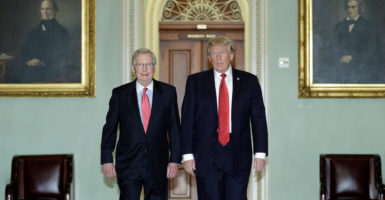One of a president’s most profound and lasting legacies is his appointment of federal judges.
Supreme Court vacancies capture the most attention but are very rare, and the Supreme Court hears less than 1 percent of the appeals it receives. The ongoing appointment of judges to the other federal courts can actually have the biggest impact.
The Constitution established the Supreme Court, and Congress created the rest of the courts. Today, the District Courts, Courts of Appeals, and Supreme Court have a total of 851 judgeships in jurisdictions around the country.
Vacancies on these courts, however, are all filled the same way: The president makes nominations but can appoint someone he has nominated only with the Senate’s consent.
The number of vacancies, and therefore the number of appointment opportunities, can be unpredictable because judges on these courts do not have specific terms. The vast majority of vacancies occur when judges choose to retire from active judicial service or are appointed to a different judicial position.
A president’s success in filling judicial vacancies depends on his determination to make nominations and the Senate’s progress in approving them.
When President Donald Trump took office, 14.3 percent of the positions on these life-tenured courts were vacant, much higher than under any of the previous five presidents.
In his first 18 months in office, Trump’s nomination pace and the Senate Judiciary Committee’s hearing pace were each more than 40 percent faster than the average under those five predecessors during the same period in their presidencies.
Unfortunately, however, final approval of Trump’s judicial nominees during his first 18 months lagged 25 percent behind the pace of his predecessors. Democrats have forced the Senate to take unnecessary separate votes for ending debate on nominees, demanded extensive time to “debate” nominees who had no opposition, and insisted on time-consuming recorded votes to approve nominations.
Separately, and especially in combination, seemingly insignificant steps such as these can add days to the confirmation timeline for each nomination.
>>> How the Judicial Confirmation Process Got So Bad
But things are looking up in a couple of different ways.
First, the overall confirmation pace has markedly improved in the last few months. The three-month total of 39 confirmations during August-October was exceeded only five times since 1949. As their arbitrary and unprecedented obstruction tactics have been exposed, Democrats have used them less. As a result, Trump is now slightly ahead of the average confirmation pace of his five predecessors at the same point in their presidencies.
Second, the decision by Trump and Senate Republican leaders to prioritize filling vacancies on the Courts of Appeals is working. Trump has already appointed more appeals-court judges than any new president in history, with at least a few more expected by the end of the year.
When the Senate reconvenes after the election, we will know what the partisan landscape will look like in the 116th Congress, which begins on Jan. 3.
There will still be work to do, however, because 32 judicial nominees are on the full Senate’s docket, and another 22 are ready for Judiciary Committee hearings or approval. That would make Trump’s first two years a real judicial confirmation triumph.
Originally published by National Review.




























